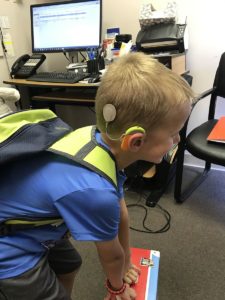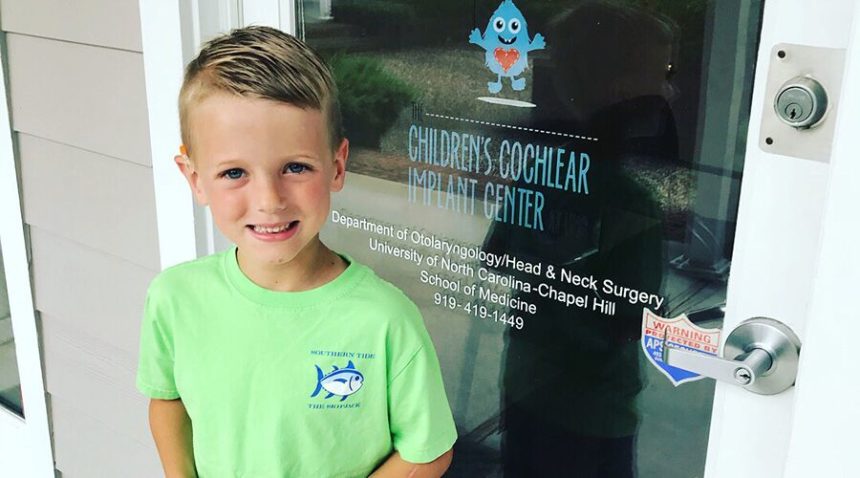A cochlear implant helps a child with single-sided deafness.
Until age 4, Sam Hollamon was a vivacious, bright preschooler who loved to swim and spend time with his family at Lake Murray near their home in Columbia, South Carolina.
That all changed when a surgery to fix a small hole in his eardrum resulted in a total sensory hearing loss in his right ear, most likely because of an infection following surgery.
This left Sam with two problems. First, he had a persistent large perforation in his eardrum, as his surgery in Columbia was not successful. Without an eardrum, Sam was at risk of infection every time he swam in the family pool or waded into the murky waters of Lake Murray.
Second, the total sensory loss of hearing in one ear made it more difficult for Sam to localize sounds, meaning he could not determine the direction of sound. He also struggled with understanding speech in noisy environments. This meant he struggled during soccer games and at school because the onslaught of different sounds was too much for him to process.
“He had to be taken out of his school assemblies because it was too loud for him. He would just cover his ears and say it hurts,” says his mom, Laura Hollamon. A onetime social butterfly, Sam became shy and withdrawn. And he was frequently tired after school, as he was working so hard to hear with his “good” ear.
“Think about what it must be like for a child to be forced to listen through only one ear over the course of a school day. Imagine how much they have to strain and focus to understand what their classmates and teacher are saying,” says Kevin Brown, MD, PhD, chief of Otology/Neurotology and Skull Base Surgery at UNC Medical Center. “It’s very common at the end of the day for these children to be exhausted and just want to crawl into bed to nap.”
This is one reason why children with single-sided deafness are more likely to struggle in school—they cannot focus as well as other children due to fatigue, Dr. Brown says.
Hollamon didn’t want this to happen to her precocious son, but Sam’s doctors in Columbia said there was nothing they could do for him. They did not want to try to rebuild his eardrum until Sam was at least 11 because the surgery was so complex. The surgery, called a tympanoplasty, requires a surgeon to rebuild the eardrum using a tissue graft, and it can be much more difficult in younger children.
Still, Hollamon was determined to find someone who could help her son. Sam’s hearing intervention teacher recommended Sam see UNC Medical Center pediatric audiologist Patricia Roush, AuD, and Dr. Brown.
 “Pat was utterly amazing and spent two days with us because Sam was sick the first day, so she went out of her way to get a better reading when he was feeling better,” Hollamon says. They also saw Dr. Brown, who discussed that getting Sam to hear again would require two steps. First, Sam would need a surgery to repair the eardrum and make his ear safe again. Second, he could hear again on that side if he received a cochlear implant.
“Pat was utterly amazing and spent two days with us because Sam was sick the first day, so she went out of her way to get a better reading when he was feeling better,” Hollamon says. They also saw Dr. Brown, who discussed that getting Sam to hear again would require two steps. First, Sam would need a surgery to repair the eardrum and make his ear safe again. Second, he could hear again on that side if he received a cochlear implant.
Fortunately for Sam, Dr. Brown, along with Lisa Park, AuD, were working on an FDA-approved clinical trial to place cochlear implants in children with single-sided deafness. A cochlear implant is an electronic device surgically placed in the cochlea that helps restore the capacity to hear again in the deafened ear.
Sam qualified for the study and was actually the first child to enroll in it. “It made a huge difference in his ability to localize the direction that sound is coming from,” Dr. Brown says. “He went from no speech understanding to having a speech understanding of almost 80 percent in that ear that was previously deafened.”

Now, two years later, Sam is back to his spirited self. He’s traded his soccer ball for a baseball, and he still loves swimming in the family pool and exploring the waters of Lake Murray. And not only does he like school assemblies, but he even led the school cheer at a recent one.
He wears his implant every day with pride, Hollamon says. When Sam, 7, had to write about the best part of himself for a school assignment, he said it was his cochlear implant because of all the things it enabled him to do.
“Just because a child can hear normally from one ear doesn’t mean that they aren’t dealing with a disability. It has significant social and educational impacts on them over their lifetime,” Dr. Brown says. “Not every child is going to be a candidate for an implant, and not every child is going to want one. But for those who do, it can make an enormous impact on their quality of life.”
If you’re concerned about hearing loss for you or your child, talk to your doctor. If you need a doctor, find one near you.

